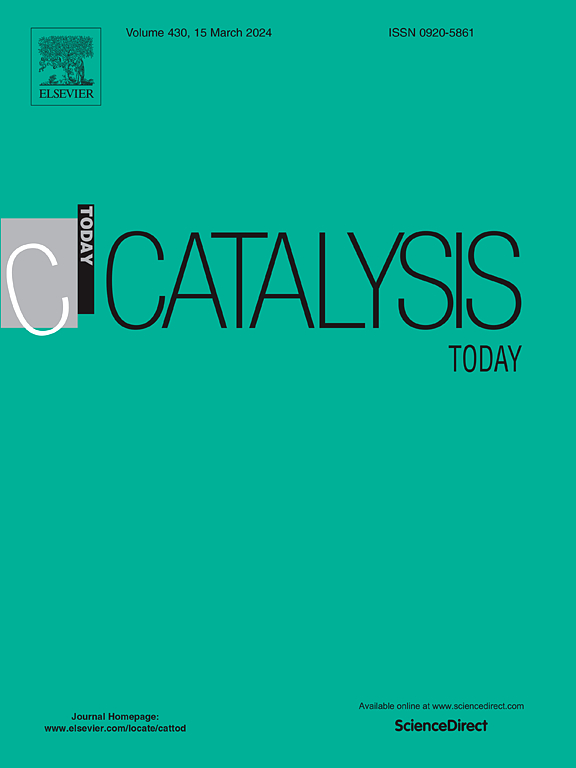Facile green synthesis of highly efficient carbon nanospheres@g-C3N4 catalysts for photodegradation of Bisphenol A
IF 5.2
2区 化学
Q1 CHEMISTRY, APPLIED
引用次数: 0
Abstract
Novel Carbon nanospheres@graphitic-carbon nitride nanocomposites were successfully synthesized by a simple, inexpensive and ecofriendly chemical method (hydrothermal). The as-prepared materials Carbon nanospheres (CNS), pure g-C3N4, CNS@g-C3N4 and heat treated (HT)CNS@g-C3N4 were characterized by FTIR, Raman spectroscopy, XPS, XRD, TEM, EDX and N2-adsorption desorption, UV-Visible DRS, and Photoluminescence (PL). The photodegradation of bisphenol A (a typical endocrine disruptor) using photocatalysts was followed by HPLC-UV technique. The results show that (HT)CNS@g-C3N4 exhibits high photocatalytic efficiency for BPA degradation (99 %), which is 45 and 8.5 times greater than that of pure g-C3N4 and CNS@g-C3N4, respectively. Additionally, the (HT)CNS@g-C3N4 photocatalyst displays a high constant rate of apparent pseudo-first-order (kapp = 94.78 × 10−3 min–1) and low electrical energy per order consumption (EEO = 0.24 kWh/m3). These excellent abilities of (HT)CNS@g-C3N4 were attributed to its excellent morphological, structural and optical properties induced during the heat treatment: (i) The presence of CNS reduces the bad gap and consequently enhances the absorption of visible light and promotes the charge carriers separation, (ii) the high specific surface area and porosity and therefore availability of a high number of active sites to interact with BPA, (iii) high presence of different functional groups on the catalyst surface that enhance the interaction between the surface and BPA molecules, and (iv) The heterojunction interface created between CNS and g-C3N4 constitutes an efficient structure that enhances interfacial charge transfer and prevents direct recombination of charge carriers originating from g-C3N4. Based on the identification of the products and intermediates of the BPA photodegradation reaction, by HPLC−MS, a plausible mechanism of photocatalytic degradation of BPA using the prepared photocatalysts was proposed.
绿色合成高效碳nanospheres@g-C3N4光降解双酚A催化剂
采用简单、廉价、环保的化学方法(水热法)成功合成了新型碳nanospheres@graphitic-carbon氮化纳米复合材料。采用FTIR、拉曼光谱、XPS、XRD、TEM、EDX、n2吸附解吸、uv -可见DRS和光致发光等手段对制备的碳纳米球(CNS)、纯g-C3N4、CNS@g-C3N4和热处理(HT)CNS@g-C3N4进行了表征。采用高效液相色谱-紫外分光光度法对双酚A(一种典型的内分泌干扰物)进行了光催化降解。结果表明,(HT)CNS@g-C3N4对BPA的光催化降解效率高达99 %,分别是纯g-C3N4和CNS@g-C3N4的45倍和8.5倍。此外,(HT)CNS@g-C3N4光催化剂具有较高的准一阶表观恒定速率(kapp = 94.78 × 10−3 min-1)和较低的单阶电能消耗(EEO = 0.24 kWh/m3)。(HT)CNS@g-C3N4这些优异的性能归功于其在热处理过程中产生的优异的形态、结构和光学性能。(i) CNS的存在减少了不良间隙,从而增强了对可见光的吸收,促进了载流子的分离;(ii)具有高比表面积和孔隙度,从而可以获得大量与BPA相互作用的活性位点;(iii)催化剂表面存在大量不同的官能团,从而增强了表面与BPA分子之间的相互作用。(iv)在CNS和g-C3N4之间形成的异质结界面构成了一种有效的结构,增强了界面电荷转移,阻止了g-C3N4产生的载流子的直接重组。在对双酚a光降解产物和中间体进行鉴定的基础上,采用HPLC - MS对制备的双酚a光催化剂进行光催化降解的机理进行了初步探讨。
本文章由计算机程序翻译,如有差异,请以英文原文为准。
求助全文
约1分钟内获得全文
求助全文
来源期刊

Catalysis Today
化学-工程:化工
CiteScore
11.50
自引率
3.80%
发文量
573
审稿时长
2.9 months
期刊介绍:
Catalysis Today focuses on the rapid publication of original invited papers devoted to currently important topics in catalysis and related subjects. The journal only publishes special issues (Proposing a Catalysis Today Special Issue), each of which is supervised by Guest Editors who recruit individual papers and oversee the peer review process. Catalysis Today offers researchers in the field of catalysis in-depth overviews of topical issues.
Both fundamental and applied aspects of catalysis are covered. Subjects such as catalysis of immobilized organometallic and biocatalytic systems are welcome. Subjects related to catalysis such as experimental techniques, adsorption, process technology, synthesis, in situ characterization, computational, theoretical modeling, imaging and others are included if there is a clear relationship to catalysis.
 求助内容:
求助内容: 应助结果提醒方式:
应助结果提醒方式:


